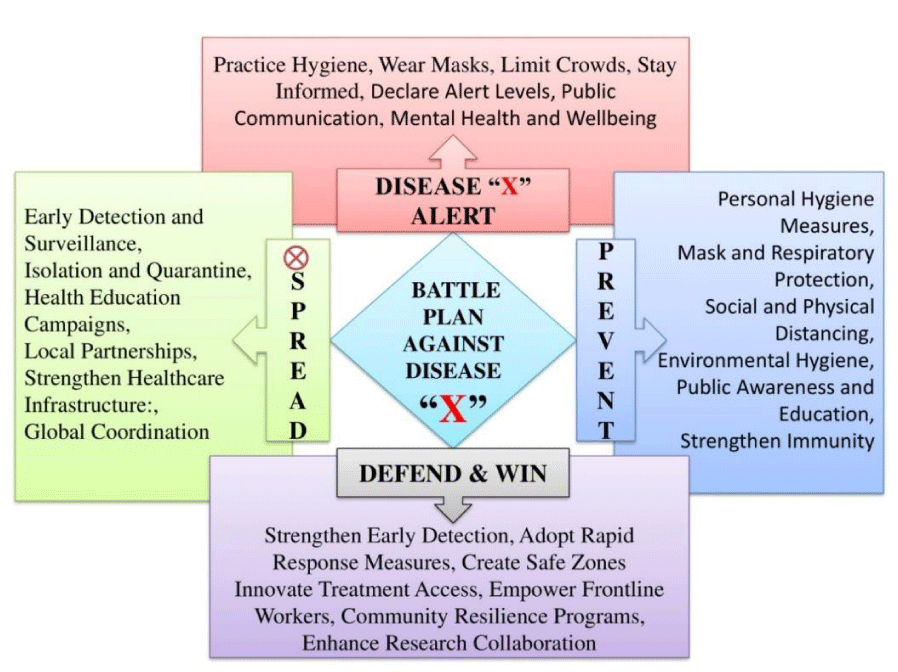Annals of Antivirals and Antiretrovirals
Scientific Perspective on Disease “X”
Dharmendra Kumar*
Associate Professor, Sanskaram College of Pharmacy, Sanskaram University, Jhajjar, Haryana, 124108, India
Cite this as
Kumar D. Scientific Perspective on Disease “X”. Ann Antivir Antiretrovir. 2025; 9(1): 001-003. Available from: 10.17352/aaa.000019Copyright
© 2025 Kumar D. This is an open-access article distributed under the terms of the Creative Commons Attribution License, which permits unrestricted use, distribution, and reproduction in any medium, provided the original author and source are credited.A new and mysterious illness, termed Disease X, poses a potential threat to the global population of 8.2 billion people. To date, neither the causative agent of Disease X has been identified, nor has any effective cure or preventive measure been developed. In February 2018, the World Health Organization (WHO) included Disease X in its list of «blueprint priority diseases,» symbolizing a hypothetical and unknown pathogen with the potential to trigger a large-scale epidemic. Despite ongoing efforts, the origins and mechanisms of Disease X remain elusive, emphasizing the importance of preparedness. The scientific community is actively investigating potential causes and preventive strategies for Disease X, while the general population, preoccupied with daily challenges, remains largely unaware of the imminent risks. Richard Hatchett, CEO of the Coalition for Epidemic Preparedness Innovations (CEPI), highlighted the seriousness of the situation, stating, “It may seem like science fiction, but we must be ready for Disease X.” The WHO has prioritized Disease X alongside known pathogens like Ebola, Zika, and SARS-CoV-2 (the virus responsible for COVID-19). The designation “X” reflects the unknown nature of the pathogen, underscoring the uncertainty surrounding its origin, transmission dynamics, and clinical presentation. This study is useful for raising awareness among the population about potential viral outbreaks or pandemics. It also serves as a valuable resource for the scientific community and government authorities to prepare for and combat viral threats effectively.
Correlation with existing diseases
Emerging research has drawn parallels between Disease X and other high-impact infections, including respiratory diseases, vector-borne diseases, and parasitic infections. Multiple hypotheses have been proposed to understand the potential similarities and pathways of Disease X, as comparisons to other diseases provide critical insights into its possible nature, transmission, and impact on public health.
- Comparison with Respiratory Diseases: Some researchers suggest that Disease X may share similarities with diseases like Ebola, Zika, SARS-CoV-2 (COVID-19), and other respiratory pathogens. These comparisons highlight its potential respiratory transmission characteristics and mechanisms of immune evasion. A recent study proposed that Disease X could represent a “next-generation pathogen” resembling the respiratory and systemic effects observed in these diseases [1].
- Similarity to malaria: An emerging body of evidence suggests that Disease X could share genetic or pathogenic mechanisms with malaria, a vector-borne parasitic disease caused by Plasmodium species and transmitted primarily by Anopheles mosquitoes [2]. This correlation is based on potential vector-borne pathways and immune response evasion strategies. According to another study, if Disease X relies on vector-borne transmission, it could mirror the complex challenges faced in malaria control, particularly in resource-limited settings. Malaria is characterized by fever, chills, fatigue, and immune suppression, traits that could overlap with hypothetical clinical presentations of Disease X. Understanding the pathophysiological links between these diseases could provide insights into vector surveillance, early warning mechanisms, and targeted control measures [2,3].
- Vector-Borne Pathogens: The hypothesis of Disease X as a vector-borne pathogen has led to comparisons with arboviruses, such as Zika and dengue, which are spread by mosquito vectors. These diseases depend on insect carriers for their transmission, and researchers like a study suggest that Disease X may adopt a similar vector-based transmission pathway. Vector-borne transmission would imply an intricate relationship with environmental changes, human travel patterns, and urbanization, much like how climate change has amplified the spread of diseases like malaria and Zika [2,4].
- Comparison with viral hemorrhagic fevers: Diseases such as Ebola and Marburg virus infections, classified as Viral Hemorrhagic Fevers (VHFs), exhibit many of the immunological and clinical features that researchers speculate might overlap with Disease X. VHFs are characterized by systemic immune responses, vascular permeability, and multi-organ failure, which could potentially represent similar biological pathways to those that might underpin Disease X’s progression.
- Chronic and immune-related diseases: Researchers have also explored correlations with chronic diseases and immune system disorders, such as autoimmune diseases and immune pathological responses, which have been observed in diseases like HIV/AIDS. These comparisons highlight a potential immune dysregulation pathway, with Disease X triggering systemic immune suppression or immune hyperactivation. Similar immune system interference has been noted during the progression of chronic inflammatory diseases and respiratory viral infections.
Global preparedness and response challenges
The response to previous pandemics such as Ebola, Zika, and COVID-19 revealed critical gaps in the global public health system [5,6]. Public dissatisfaction has often been directed at the WHO and national governments, citing inadequate funding, delays in decision-making, and political pressures as major limitations in managing these crises. Moving forward, Disease X presents a test for these entities to adopt proactive strategies, including:
- Enhanced disease surveillance and early detection.
- Accelerated research for diagnostics, vaccines, and therapeutics.
- Clear communication to address public fears and misinformation.
Public concerns
Following the devastation caused by recent pandemics, there is widespread fear and anxiety about the potential for Disease X to cause another global health emergency. Many communities remain ill-prepared both financially and psychologically to cope with another large-scale outbreak. The responsibility falls on governments and health organizations to rebuild public trust by demonstrating transparency and efficiency in handling such crises.
Current strategy: Distance as the only rescue
Until further scientific advancements are achieved, physical distancing remains the most reliable strategy to mitigate the spread of Disease X. This approach, proven effective during the COVID-19 pandemic, seeks to minimize human-to-human interactions and prevent potential transmission chains. Key measures include:
- Social distancing protocols
- Maintain a minimum distance of 1-2 meters between individuals in public spaces.
- Avoid large gatherings such as events, religious congregations, and celebrations.
- Remote work and education
- Encourage work-from-home arrangements and online education to reduce physical contact in workplaces and schools.
- Contactless services
- Transition to contactless delivery for essential goods, groceries, and medical supplies.
- Zonal containment strategies
- Restrict movement in high-risk zones while permitting essential activities under strict supervision.
- Travel restrictions
- Limit international and domestic travel to minimize cross-border transmission.
- Implement mandatory quarantines for travelers from affected areas.
Master plan for battle against disease X
The master plan was developed based on the conditions and challenges observed during previous pandemics, including those caused by COVID-19, Ebola, and Zika viruses as shown in Figure 1.
Conclusion
The concept of Disease X, although hypothetical, underscores the importance of prioritizing its inclusion in global research and development agendas as a proactive measure for pandemic preparedness. It highlights the critical need for coordinated efforts by scientific and political leadership to address existing gaps in pandemic response frameworks and build resilience against potential unknown threats. To date, maintaining physical distancing has been one of the most effective non-pharmaceutical interventions in mitigating the spread of infectious diseases. However, this underscores the urgency of advancing research, infrastructure, and collaborative strategies to enhance future response capabilities.
Although AI-generated tools were used to generate this Article, the concepts and central ideas it contains were entirely original and devised by a human writer. The AI merely assisted in the writing process, but the creative vision and intellectual property belong to the human author.
- Research response to pathogen X during a pandemic. World Health Organization. Published January 19, 2024. Available from: https://www.who.int/news-room/events/detail/2024/01/19/default-calendar/Research-response-to-pathogen-X-during-a-pandemic
- Holt RA, Subramanian GM, Halpern A, Sutton GG, Charlab R, Nusskern DR, et al. The genome sequence of the malaria mosquito Anopheles gambiae. Science. 2002;298(5591):129–149. Available from: https://doi.org/10.1126/science.1076181
- Kebede T, Kumar D, Sharma PK. Potential drug options for treatment of COVID-19: A review. Coronaviruses. 2020;1(1):42-48. Available from: http://dx.doi.org/10.2174/2666796701999200701131604
- Jiang S, Shi ZL. The first Disease X is caused by a highly transmissible acute respiratory syndrome coronavirus. Virol Sin. 2020;35:263–265. Available from: https://doi.org/10.1007/s12250-020-00206-5
- Gwinn M, MacCannell D, Armstrong GL. Next-generation sequencing of infectious pathogens. JAMA. 2019 Mar 5;321(9):893-894. Available from: https://doi.org/10.1001/jama.2018.21669
- Kumar D, Malviya R, Sharma PK. Corona virus: A review of COVID-19. Eurasian J Med Oncol. 2020;4:8–25. Available from: https://doi.org/10.14744/ejmo.2020.51418
Article Alerts
Subscribe to our articles alerts and stay tuned.
 This work is licensed under a Creative Commons Attribution 4.0 International License.
This work is licensed under a Creative Commons Attribution 4.0 International License.



 Save to Mendeley
Save to Mendeley
